Related Research Articles
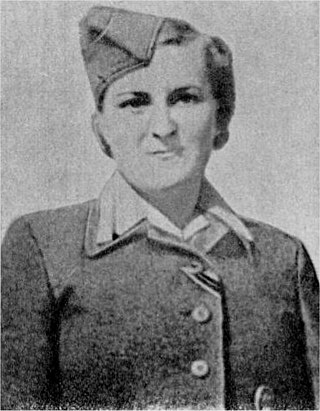
Hermine Braunsteiner Ryan was a Nazi Austrian SS Helferin and female camp guard at Ravensbrück and Majdanek concentration camps, and the first Nazi war criminal to be extradited from the United States to face trial in West Germany. Braunsteiner was known to prisoners of Majdanek concentration camp as the "Stomping Mare" and was said to have beaten prisoners to death, thrown children by their hair onto trucks that took them to be murdered in gas chambers, hanged young prisoners and stomped an old prisoner to death with her jackboots.

Stutthof was a Nazi concentration camp established by Nazi Germany in a secluded, marshy, and wooded area near the village of Stutthof 34 km (21 mi) east of the city of Danzig (Gdańsk) in the territory of the German-annexed Free City of Danzig. The camp was set up around existing structures after the invasion of Poland in World War II and initially used for the imprisonment of Polish leaders and intelligentsia. The actual barracks were built the following year by prisoners. Most of the infrastructure of the concentration camp was either destroyed or dismantled shortly after the war. In 1962, the former concentration camp with its remaining structures, was turned into a memorial museum.

Hildegard Martha Lächert was a female guard, or Aufseherin, at several concentration camps controlled by Nazi Germany. She became publicly known for her service at Ravensbrück, Majdanek and Auschwitz-Birkenau.

Aufseherin was the position title for a female guard in Nazi concentration camps. Of the 50,000 guards who served in the concentration camps, training records indicate that approximately 3,500 were women. In 1942, the first female guards arrived at Auschwitz and Majdanek from Ravensbrück. The year after, the Nazis began conscripting women because of a shortage of male guards. In the context of these camps, the German position title of Aufseherin translates to (female) "overseer" or "attendant". Later female guards were dispersed to Bolzano (1944–1945), Kaiserwald-Riga (1943–44), Mauthausen, Stutthof (1942–1945), Vaivara (1943–1944), Vught (1943–1944), and at Nazi concentration camps, subcamps, work camps, detention camps and other posts.

Maria Mandl was an Austrian SS-Helferin and a war criminal known for her role in the Holocaust as a top-ranking official at the Auschwitz-Birkenau extermination camp, where she is believed to have been directly complicit in the deaths of over 500,000 prisoners. She was executed for war crimes.

Gerda Steinhoff was a Schutzstaffel (SS) Nazi concentration camp overseer following the 1939 German invasion of Poland.
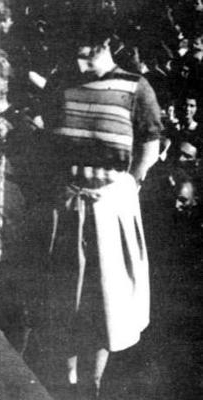
Ewa Paradies was a Nazi concentration camp overseer.
Margot Elisabeth Dreschel, also spelled Drechsler, or Drexler, was a prison guard at Nazi concentration camps during World War II. For her role in the Holocaust, she was sentenced to death and hanged.

Ruth Closius-Neudeck was a Nazi Schutzstaffel (SS) supervisor at a Nazi concentration camp complex from December 1944 until March 1945. She was executed for war crimes for her role in the Holocaust.
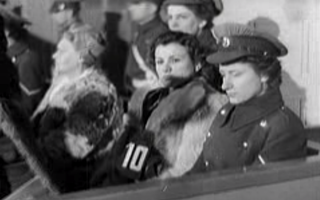
The Hamburg Ravensbrück trials were seven trials for war crimes during the Holocaust against camp officials from the Ravensbrück concentration camp that the British authorities held in their occupation zone in Germany in Hamburg after the end of World War II. These trials were heard before a military tribunal; the three to five judges at these trials were British officers, assisted by a lawyer. The defendants included concentration camp personnel of all levels: SS officers, camp doctors, male guards, female guards (Aufseherinnen), and a few former prisoner-functionaries who had tortured or mistreated other inmates. In total, 38 defendants were tried in these seven trials; 21 of the defendants were women. One of the defendants died during the trial. Twenty of the defendants received death sentences. One defendant was reprieved while two others committed suicide before they could be executed. The remaining 17 death sentences relating to these trials were carried out on the gallows at Hamelin Prison by British hangman Albert Pierrepoint.

Alice Orlowski was a German concentration camp guard at several of the Nazi concentration camps in German-occupied Poland (1939-1945) during World War II. After the war, a Polish court convicted of her crimes against humanity, and she served 10 years in prison in Poland. In 1973, Orlowski, now 70 and living as a pensioner in West Germany, muttered that only "half the work" had been finished, referring to the Holocaust. She was promptly arrested, convicted of making antisemitic remarks, and sentenced to 10 months in prison.
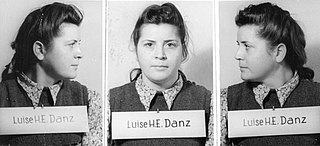
Luise Danz was a Nazi concentration camp guard in World War II. Danz was captured in 1945 and put on trial for crimes against humanity at the Auschwitz trial in Kraków, Poland. She was sentenced to life imprisonment in 1947, but released due to general amnesty on 20 August 1957.

The Dachau trials, also known as the Dachau Military Tribunal, handled the prosecution of almost every war criminal captured in the U.S. military zones in Allied-occupied Germany and in Allied-occupied Austria, and the prosecutions of military personnel and civilian persons who committed war crimes against the American military and American citizens. The war-crime trials were held within the compound of the former Dachau concentration camp by military tribunals authorized by the Judge Advocate General of the U.S. Third Army.
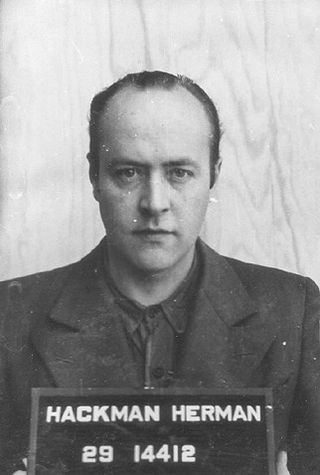
Hermann Wilhelm Hackmann was a German war criminal, Nazi SS captain in two extermination camps during World War II. He was a roll call officer at KL Buchenwald, and lead guard in charge of the so-called protective custody at Majdanek concentration camp in German-occupied Poland. Described as a brutal man with a cynical sense of humour, Hackmann was tried three times. The first time, he was prosecuted for murder and embezzlement and sentenced to death by SS Judge Georg Konrad Morgen in connection with the Koch trial. However, Hackmann's sentence was later commuted to a prison term. He spent at least five months as a regular prisoner in Dachau concentration camp before being transferred to a penal battalion.

The Stutthof trials were a series of war crime tribunals held in postwar Poland for the prosecution of Stutthof concentration camp staff and officials, responsible for the murder of up to 85,000 prisoners during the occupation of Poland by Nazi Germany in World War II. None of the Stutthof commandants were ever tried in Poland. SS-Sturmbannführer Max Pauly was put on trial by a British military court in Germany but not for the crimes committed at Stutthof; only as the commandant of the Neuengamme concentration camp in Hamburg. Nevertheless, Pauly was executed in 1946.

Ernst Heinrich Schmidt was a German physician and member of the SS, who practised Nazi medicine in a variety of German concentration camps during World War II. He was tried in 1947 and 1975 for complicity in war crimes, but was acquitted both times.
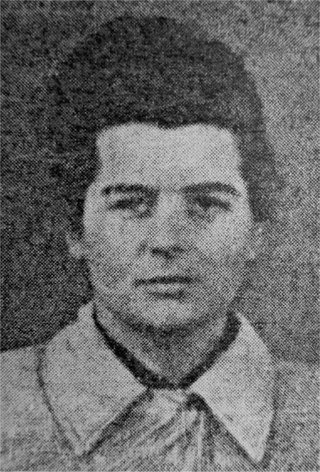
Else Lieschen Frida "Elsa" Ehrich was a convicted war criminal who served as a Schutzstaffel (SS) guard in Nazi concentration camps, including at Kraków-Płaszów and the Majdanek concentration camp during World War II. She was tried in Lublin, Poland at the Majdanek Trials and sentenced to death for war crimes. Ehrich was hanged on 26 October 1948.

Gertrud Elli Heise was a female guard and later, SS overseer at several concentration camps during the Second World War. Heise was born in Berlin, Germany. She was tried for war crimes in 1946.
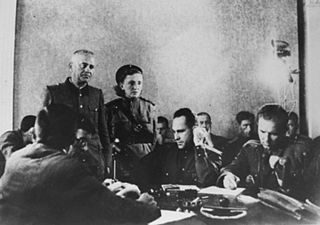
The Majdanek trials were a series of consecutive war-crime trials held in Poland and in Germany during and after World War II, constituting the overall longest Nazi war crimes trial in history spanning over 30 years. The first judicial trial of Majdanek extermination camp officials took place from November 27, 1944, to December 2, 1944, in Lublin, Poland. The last one, held at the District Court of Düsseldorf began on November 26, 1975, and concluded on June 30, 1981. It was West Germany's longest and most expensive trial, lasting 474 sessions.

Otto Hantke was a German SS-Unterscharführer, convicted murderer, and war criminal in German-occupied Poland during the Holocaust. Hantke joined the Nazi Party and the SS by 1933. Between at least 1942 and 1944, Hantke served as the commandant of the Budzyń labor camp and Poniatowa concentration camp, both subcamps of the Majdanek concentration camp, and was an SS officer at the Lipowa 7 concentration camp and Stutthof concentration camp.
References
- ↑ Brown, Daniel Patrick (2002). The Camp Women: The Female Auxiliaries who Assisted the SS in Running the Nazi Concentration Camp System. Schiffer Pub. ISBN 978-0-7643-1444-5.
- ↑ "Biogramy".
- ↑ Mailänder, Elissa; Szobar, Patricia (2015). Female SS Guards and Workaday Violence: The Majdanek Concentration Camp, 1942-1944. Michigan State University Press. ISBN 978-1-61186-170-9. JSTOR 10.14321/j.ctt13x0pbd.
- ↑ stutthof.org/projekty/zeszyty/5/8.pdf
- ↑ Aleksander Lasik
- ↑ Der Ort des Terrors: Geschichte der nationalsozialistischen ..., Volume 4 edited by Wolfgang Benz, Barbara Distel, Angelika Königseder
- ↑ "Third Majdanek Trial (1975-1981)".